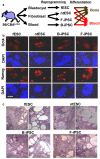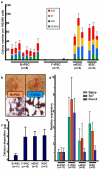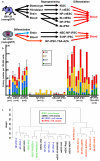Epigenetic memory in induced pluripotent stem cells
- PMID: 20644535
- PMCID: PMC3150836
- DOI: 10.1038/nature09342
Epigenetic memory in induced pluripotent stem cells
Abstract
Somatic cell nuclear transfer and transcription-factor-based reprogramming revert adult cells to an embryonic state, and yield pluripotent stem cells that can generate all tissues. Through different mechanisms and kinetics, these two reprogramming methods reset genomic methylation, an epigenetic modification of DNA that influences gene expression, leading us to hypothesize that the resulting pluripotent stem cells might have different properties. Here we observe that low-passage induced pluripotent stem cells (iPSCs) derived by factor-based reprogramming of adult murine tissues harbour residual DNA methylation signatures characteristic of their somatic tissue of origin, which favours their differentiation along lineages related to the donor cell, while restricting alternative cell fates. Such an 'epigenetic memory' of the donor tissue could be reset by differentiation and serial reprogramming, or by treatment of iPSCs with chromatin-modifying drugs. In contrast, the differentiation and methylation of nuclear-transfer-derived pluripotent stem cells were more similar to classical embryonic stem cells than were iPSCs. Our data indicate that nuclear transfer is more effective at establishing the ground state of pluripotency than factor-based reprogramming, which can leave an epigenetic memory of the tissue of origin that may influence efforts at directed differentiation for applications in disease modelling or treatment.
Figures




Comment in
-
Stem cells: Troublesome memories.Nature. 2010 Sep 16;467(7313):280-1. doi: 10.1038/467280a. Nature. 2010. PMID: 20844526 No abstract available.
References
Method Reference
-
- Kirov G, et al. Variation in the protocadherin gamma A gene cluster. Genomics. 2003;82:433–440. - PubMed
References
-
- Takahashi K, Yamanaka S. Induction of pluripotent stem cells from mouse embryonic and adult fibroblast cultures by defined factors. Cell. 2006;126:663–676. Epub 2006 Aug 2010. - PubMed
-
- Zhao XY, et al. iPS cells produce viable mice through tetraploid complementation. Nature. 2009;461:86–90. - PubMed
-
- Daley GQ, et al. Broader implications of defining standards for the pluripotency of iPSCs. Cell Stem Cell. 2009;4:200–201. author reply 202. - PubMed
Publication types
MeSH terms
Substances
Associated data
- Actions
Grants and funding
- HL099999/HL/NHLBI NIH HHS/United States
- R01AI047458/AI/NIAID NIH HHS/United States
- R01-DK70055/DK/NIDDK NIH HHS/United States
- R01 DK059279/DK/NIDDK NIH HHS/United States
- R37 CA054358/CA/NCI NIH HHS/United States
- P50 HG003233/HG/NHGRI NIH HHS/United States
- RC2-HL102815/HL/NHLBI NIH HHS/United States
- R01 DK070055/DK/NIDDK NIH HHS/United States
- CA86065/CA/NCI NIH HHS/United States
- R37 HD045022/HD/NICHD NIH HHS/United States
- K99 HL093212/HL/NHLBI NIH HHS/United States
- R37CA054358/CA/NCI NIH HHS/United States
- R01AI047457/AI/NIAID NIH HHS/United States
- P50HG003233/HG/NHGRI NIH HHS/United States
- R01 AI047457/AI/NIAID NIH HHS/United States
- R01-DK59279/DK/NIDDK NIH HHS/United States
- R01 CA086065/CA/NCI NIH HHS/United States
- HHMI/Howard Hughes Medical Institute/United States
- U01 HL099999/HL/NHLBI NIH HHS/United States
- K99HL093212-01/HL/NHLBI NIH HHS/United States
- R01 GM083084/GM/NIGMS NIH HHS/United States
- R01 AI047458/AI/NIAID NIH HHS/United States
- DP1 OD000256/OD/NIH HHS/United States
- RC2 HL102815/HL/NHLBI NIH HHS/United States
LinkOut - more resources
Full Text Sources
Other Literature Sources
Molecular Biology Databases

